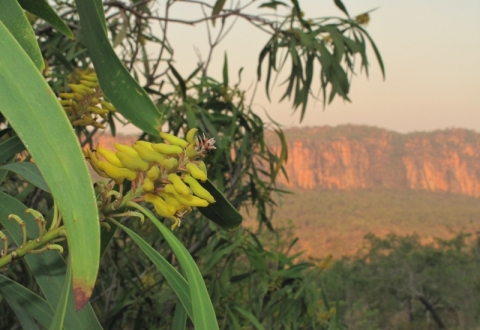Persoonia falcata
R.Br.
Proteaceae
Linkia falcata (R.Br.) Kuntze
Common Name:
General Information
Persoonia falcata is a shrub or small tree growing from 1 - 9 metres tall[
,
].
The fruit was a popular food of the Australian Aborigines[
193- Title
- Wild Food Plants of Australia.
- Publication
-
- Author
- Low. T.
- Publisher
- Angus and Robertson.
- Year
- 1989
- ISBN
- 0-207-14383-8
- Description
- Well presented, clear information and good photographs. An interesting read for the casual reader as well as the enthusiast
]. The plant is sometimes harvested from the wild for local use as a food, medicine and source of wood.
Known Hazards
None known
Botanical References
,
Range
Australia - Queensland, Northern Territory, Western Australia.
Habitat
Watercourses, sandstone cliffs and rocks, sometimes in gorges, growing in sand, sandstone and alluvium[
]. Mainly in Eucalyptus woodland, but also in Melaleuca woodland, mixed woodland, or the margins of vine thickets, and occasionally in heath[
].
Properties
| Edibility Rating |      |
| Medicinal Rating |      |
| Other Uses Rating |      |
| Habit | Tree |
| Height | 5.00 m |
| Cultivation Status | Wild |
Cultivation Details
A plant of the lowland tropics, where it is found at elevations up to 900 metres. It grows best in areas where annual daytime temperatures are within the range 22 - 38°c, but can tolerate 2 - 41°c[
]. It prefers a mean annual rainfall in the range 600 - 1,400mm, but tolerates 450 - 1,750mm[
].
Grows best in a sunny position, tolerating light shade[
]. Plants are found in the wild in well-drained substrata, most commonly in sand derived from sandstone or granite, or on dunes, but also in lateritic soils or on stony hillsides and rarely in clay[
]. Prefers a pH in the range 5 - 6, tolerating 4.5 - 6.5[
].
The plant has epicormic buds[
]. These are dormant leaf shoots on the main bole that are sometimes stimulated into growth, often through damage to the crown of the tree[
K- Title
- Plants for a Future
- Author
- Ken Fern
- Description
- Notes from observations, tasting etc at Plants For A Future and on field trips.
].
Edible Uses
Fruit - raw[
]. Fleshy[
]. A sweet-tasting, fibrous pulp, it is a bit like eating sweet cotton wool[
193- Title
- Wild Food Plants of Australia.
- Publication
-
- Author
- Low. T.
- Publisher
- Angus and Robertson.
- Year
- 1989
- ISBN
- 0-207-14383-8
- Description
- Well presented, clear information and good photographs. An interesting read for the casual reader as well as the enthusiast
]. The pale green, round fruits are 7 - 20mm in diameter[
193- Title
- Wild Food Plants of Australia.
- Publication
-
- Author
- Low. T.
- Publisher
- Angus and Robertson.
- Year
- 1989
- ISBN
- 0-207-14383-8
- Description
- Well presented, clear information and good photographs. An interesting read for the casual reader as well as the enthusiast
].
Medicinal
An infusion of the leaves and bark are used as a treatment against sore throat and colds[
].
Other Uses
The wood can be used or small posts and ornamental items[
].
The wood is used for fuel[
].
Propagation
Seed
If you have any useful information about this plant, please leave a comment. Comments have to be approved before they are shown here.





 Useful Tropical Plants Database 2014 by
Ken Fern,
web interface by
Ajna Fern
with help from
Richard Morris.
Useful Tropical Plants Database 2014 by
Ken Fern,
web interface by
Ajna Fern
with help from
Richard Morris.